Battle of Corregidor
| Battle of Corregidor | |||||||
|---|---|---|---|---|---|---|---|
| Part of World War II, Pacific Front | |||||||
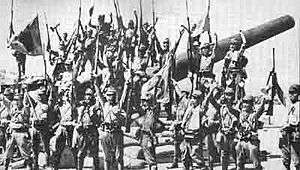 Victorious Japanese troops atop the Hearn Battery, May 6, 1942. | |||||||
| |||||||
| Belligerents | |||||||
|
| |||||||
| Commanders and leaders | |||||||
|
|
| ||||||
| Strength | |||||||
| 13,000 US and Filipino troops | 75,000 Japanese troops | ||||||
| Casualties and losses | |||||||
|
800 killed 1,000 wounded 11,000 POWs |
900 killed 1,200 wounded | ||||||
The Battle of Corregidor, fought May 5–6, 1942, was the culmination of the Japanese campaign for the conquest of the Commonwealth of the Philippines during World War II.
The fall of Bataan on April 9, 1942 ended all organized opposition by the U.S. Army Forces Far East to the invading Japanese forces on Luzon in the northern Philippines. The island bastion of Corregidor, with its network of tunnels and formidable array of defensive armament, along with the fortifications across the entrance to Manila Bay, was the remaining obstacle to the 14th Japanese Imperial Army of Lieutenant General Masaharu Homma. The Japanese had to take Corregidor; as long as the island remained in American hands, they would be denied the use of Manila Bay, the finest natural harbor in the Far East.
The US army recaptured the island in 1945.
Background
Gibraltar of the East
Corregidor, officially named Fort Mills, was the largest of four fortified islands protecting the mouth of Manila Bay from attack and was fortified prior to World War I with powerful coastal artillery. At 3.5 mi (5.6 km) long and 1.5 mi (2.4 km) across at its head, the tadpole-shaped island lay 2 mi (1.7 nmi; 3.2 km) from Bataan. Its widest but elevated area, known as Topside, contained most of its 56 coastal artillery pieces and installations.

Middleside was a small plateau containing more battery positions as well as barracks. Bottomside was the low ground where a dock area and the civilian town of San Jose was located. American servicemen alternately dubbed it "The Rock" or the "Gibraltar of the East", in reference to the peninsular fortress that guards the main entrance to the Mediterranean Sea between Europe and Africa.
The tunnel system under Malinta Hill was the most extensive construction on Corregidor. It consisted of a main east-west passage 826 ft (252 m) long with a 24 ft (7.3 m) diameter and had 25 lateral passages, each about 400 ft (120 m) long, branching out at regular intervals from each side of the main passage. A separate system of tunnels north of this main tunnel housed the underground hospital; it had its own 12 laterals (tunnels) and space for 1,000 beds. The facility could be reached either through the main tunnel or by a separate outside entrance on the north side of Malinta Hill. The Navy tunnel system, which lay opposite the hospital, under the south side of Malinta was connected to the main tunnel by a partially completed low passageway through the quartermaster storage lateral.
East of this was Malinta Tunnel, the location of General Douglas MacArthur's headquarters. Reinforced with concrete walls, floors, and overhead arches, it also had blowers to furnish fresh air, and a double-track electric tramway line along the east-west passage. The Malinta Tunnel furnished bombproof shelters for the hospital, headquarters, and shops, as well as a maze of underground storehouses.
Defenses

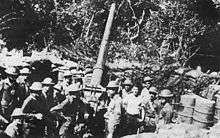
The defensive arsenal on Corregidor was formidable with 45 coastal guns and mortars organized into 23 batteries, some seventy-two anti-aircraft weapons assigned to thirteen batteries and a minefield of approximately 35 groups of controlled mines.[1] The two 12 in (300 mm) guns of Batteries Smith and Hearn, with a horizontal range of 29,000 yd (27,000 m) and all-around traverse were the longest range of all the island's artillery.
Caballo Island, with Fort Hughes—just south of Corregidor—was the next largest in size. At about 160 acres (65 ha), the island rose abruptly from the bay to a height of 380 ft (120 m) on its western side. Commander Francis J. Bridget was in charge of its beach defenses with a total of 800 men, of whom 93 were Marines and 443 belonged to the Navy, by the end of April 1942. Coastal artillery numbered some 13 assorted pieces, with its anti-aircraft defenses tied in with those of Corregidor.
Fort Drum—which lay about 4 mi (6.4 km) south of Fort Hughes—was the most unusual of the harbor defenses. Military engineers had cut away the entire top of El Fraile Island down to the water-line and used the island as a foundation to build a reinforced concrete "battleship", 350 ft (110 m) long and 144 ft (44 m) wide, with exterior walls of concrete and steel 25–36 ft (7.6–11.0 m) thick. The top deck of this concrete battleship was 40 ft (12 m) above the low-water mark and had 20 ft (6.1 m) thick walls. Equipped with four 14 in (360 mm) guns in armored turrets facing seaward, a secondary battery of four casemated 6 in (150 mm) guns, and antiaircraft defense, the fort with its 200-man garrison was considered impregnable to attack.
The last—Carabao island—lay only 500 yd (460 m) from the shores of Cavite Province. Except at one point along its eastern shore, the island rises precipitously from the sea in cliffs more than 100 ft (30 m) high. The Americans had placed Fort Frank on this island, which late in 1941, had a military garrison of about 400 men, mostly Philippine Scouts. Its armament consisted of two 14 in (360 mm) guns, eight 12 in (300 mm) mortars, four 155 mm (6.1 in) GPFs, as well as anti-aircraft and beach defense weapons.
All four forts in Manila Bay—as well as Fort Wint in Subic Bay—had been formed before the war into an organization called the Harbor Defenses of Manila and Subic Bays, which by August 1941 became a part of the Philippine Coast Artillery Command. Both were under Major General George F. Moore who also commanded the Corregidor garrison. The 5,700 men of the Harbor Defense Force were assigned to four Coast Artillery Regiments: the 59th, 60th, 91st, and 92nd CA (the 60th CA being an antiaircraft artillery unit and the 91st and 92d CA Philippine Scout units), plus headquarters and service troops.
About 500 Philippine Army soldiers in training were organized into the 1st and 2nd Coast Artillery Regiments (PA), but operated under the control of the two PS regiments. Gen. Moore organized the force into four commands to exercise tactical control: (1) seaward defense, and (2) North and South Channels defense, under Colonel Paul D. Bunker; (3) anti-aircraft and air warning defenses under Col. Theodore M. Chase, and (4) inshore patrol under Captain Kenneth M. Hoeffel of the US Navy's 16th Naval District.
After their evacuation from Olongapo in Zambales, close to Subic Naval Base on December 26, the 4th Marine Regiment—under the command of Col. Samuel L. Howard—became the primary fighting unit on the island. Corregidor's garrison received the largest group of reinforcements right after the fall of Bataan, with some 72 officers and 1,173 enlisted men from more than fifty different units were integrated and assigned to the 4th Marine Regiment. Few of the reinforcements were trained or equipped for ground combat. By April 30, 1942, the 4th Marines actually numbered 229 officers and 3,770 men, of whom only 1,500 were members of the Corps.
Siege
On December 29, 1941, the defenders got their first taste of aerial bombardment on Corregidor. The attack lasted for two hours as the Japanese destroyed or damaged the hospital, Topside and Bottomside barracks, the Navy fuel depot and the officers club. Three days later, the island garrison was bombed for more than three hours.
Periodic bombing continued over the next four days, but with only two more raids for the rest of January, the defenders had a chance to improve their positions considerably. To the amusement of the beach defenders on Corregidor, the Japanese dropped only propaganda leaflets on January 29. On March 12, under cover of darkness, Gen. MacArthur was evacuated from Corregidor, using four PT boats bound for Mindanao, from where he was eventually flown to Australia.
Henceforth, from December 29 to the end of April 1942, despite incessant Japanese aerial, naval and artillery bombardment, the garrison on Corregidor, consisting mainly of the 4th Marine Regiment and combined units from the US Navy, the Army and Filipino soldiers, resisted valiantly, inflicting heavy enemy losses in men and aircraft.
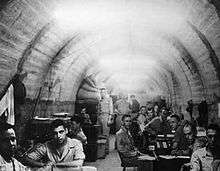
The defenders were living on about 30 ounces of food per day. Drinking water was distributed only twice per day, but the constant bombing and shelling often interrupted the distribution of rations. When the bombardment killed the mules in the Cavalry, the men would drag the carcasses down to the mess hall and they would be cooked. The continued lack of proper diet created problems for the Corregidor garrison, as men weakened and lacked reliable night vision. From Cebu, seven private maritime ships under orders from the army, loaded with a supply of food, sailed towards Corregidor. Of the seven ships, only one reached the island, the MV Princessa commanded by 3rd Lieutenant Zosimo Cruz (USAFFE).
Japanese bombing and shelling continued with unrelenting ferocity. Japanese aircraft flew 614 missions, dropping 1,701 bombs totaling some 365 tons of explosive. Joining the aerial bombardment were nine 240 mm (9.4 in) howitzers, thirty-four 149 mm (5.9 in) howitzers, and 32 other artillery pieces, which pounded Corregidor day and night. It was estimated that on May 4 alone, more than 16,000 shells hit Corregidor.
As of about April 15, 1942, the combined strength of the four fortified islands—including US Army, Philippine Scouts, Philippine Army, US Marine Corps, US Navy, Philippine Navy, and civilians—totaled about 14,728.[2]
From April 28, a concentrated aerial bombardment by the 22nd Air Brigade of Maj. Gen. Kizon Mikami—supported by ground artillery on Bataan from May 1–5, preceded landing operations.
Japanese propaganda to its home population repeatedly declared in this period that Corregidor was about to fall, followed by weeks of silence as the fall did not ensue; Imperial General Headquarters finally declared that the resistance was becoming a serious embarrassment.[3]
Fall
On May 5, Japanese forces led by Maj. Gen. Kureo Taniguchi boarded landing craft and barges and headed for the final assault on Corregidor. Shortly before midnight, intense shelling struck the beaches between North Point and Cavalry Point. The initial landing of 790 Japanese soldiers quickly bogged down due to surprisingly fierce resistance from the American and Filipino defenders whose 37 mm artillery exacted a heavy toll on the landing fleet.
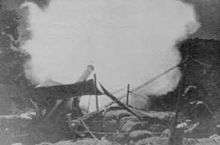
The Japanese struggled because of the strong sea currents between Bataan and Corregidor and from the layers of oil that covered the beaches from ships sunk earlier in the siege; they experienced great difficulty in landing personnel and equipment. However the overwhelming number of Japanese infantry equipped with 50 mm grenade launchers ("knee mortars") forced the defenders to pull back from the beach.
The second battalion of 785 Japanese soldiers were not as successful. They encountered the same currents but landed east of North Point, where the defensive positions of the 4th Marines were stronger. Most of the Japanese officers were killed early in the landing, the huddled survivors were hit with hand grenades, machine guns, and rifle fire. Nevertheless, some of the landing craft did reach the location of the first invasion force and together they found themselves moving inland where they had captured the Denver Battery by 01:30 on May 6.
A counterattack was initiated to eject the Japanese from the Denver Battery. This was the location of the heaviest fighting between the opposing forces, practically face to face. A few reinforcements did make their way to the frontline 4th Marines, but the battle became a duel of obsolete World War I grenades versus the accurate Japanese knee mortars. Without reinforcements, the battle would quickly go against the defenders.

By 04:30, Colonel Howard had committed his last reserves - some 500 Marines, sailors and soldiers of the 4th Battalion. These men tried to get to the battle as quickly as possible, but several Japanese snipers had slipped behind the front lines to make any movement very costly. An additional 880 Japanese reinforcements arrived at 05:30. The 4th Marines were holding their positions, at the same time losing ground in other areas. The Japanese were facing problems of their own: several ammunition crates never made the landing; as a result, several attacks and counterattacks were fought with bayonets.
The final blow to the defenders came at about 09:30, when three Japanese tanks landed and went into action. The men around Denver Battery withdrew to the ruins of a concrete trench a few yards away from the entrance to Malinta tunnel, just as Japanese artillery delivered a heavy barrage. Particularly fearful of the dire consequences should the Japanese capture the tunnel, where 1,000 helpless wounded men lay, and realizing that the defenses outside Malinta tunnel could not hold out much longer, Lt. Gen. Jonathan Wainright expected further Japanese landings that night. He also decided to sacrifice one more day of freedom in exchange for several thousand lives.
In a radio message to President Franklin Roosevelt, Wainwright said, "There is a limit of human endurance, and that point has long been passed." Howard burned the 4th Regiment's and national colors to prevent their capture by the enemy. Wainwright finally surrendered the Corregidor garrison at about 1:30 p.m. on May 6, 1942, with two officers sent forward with a white flag to carry his surrender message to the Japanese.
Aftermath
The Japanese losses from January 1 - April 30 and from the initial assault landings on May 5/6, were about 900 dead and 1,200 wounded, while the defenders suffered 800 dead and 1,000 wounded.
Corregidor's defeat marked the fall of the Philippines and Asia, but Imperial Japan's timetable for the conquest of Australia and the rest of the Pacific was severely upset. Its advance was ultimately checked at the battle for New Guinea, and at Guadalcanal, the turning point in the Pacific War.
About 4,000 of the 11,000 American and Filipino prisoners of war from Corregidor were marched through the streets of Manila to incarceration at Fort Santiago and Bilibid Prison, criminal detention centers turned POW camps. US Army and Navy nurses (the "Angels of Bataan and Corregidor") continued to work on Corregidor for several weeks, and were then sent to Santo Tomas. The rest were sent off in trains to various Japanese prison camps. General Wainwright was incarcerated in Manchuria. Over the course of the war, thousands were shipped to the Japanese home islands as slave labor. Some were eventually freed at the Raid at Cabanatuan and during the battle for Manila's liberation. While most of the Allied forces on Corregidor surrendered, many individuals continued fighting as guerrillas.
General Masaharu Homma, who conquered the Philippines in five months instead of the projected two, ended up being relieved of his command.
Historical commemoration
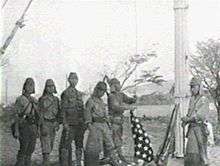
An unnamed Marine from the 4th Marine Regiment wrote the following lyrics to the tune of the ' Marines' Hymn,' just before going into battle in Corregidor. The author of "The Corregidor Hymn" was captured by the Japanese in the battle and was never seen again.
"First to jump for holes and tunnels And to keep our skivvies clean, We are proud to claim the title of Corregidor's Marines.
"Our drawers unfurled to every breeze From dawn to setting sun. We have jumped into every hole and ditch And for us the fightin' was fun.
"We have plenty of guns and ammunition But not cigars and cigarettes, At the last we may smoking leaves Wrapped in Nipponese propaganda leaflets.
"When the Army and the Navy Looked out Corregidor's Tunnel Queen, They saw the beaches guarded by more than one Marine!"
Memorials
The Pacific War Memorial was built on Corregidor in memory of the American and Filipino soldiers who died.
The bridge in Chicago, Illinois, where State Street crosses the Chicago River is named the 'Bataan-Corregidor Memorial Bridge'.
See also
- Battle of Bataan
- Philippines Campaign (1941–42)
- The History Channel: Battle for the Pacific, the battle is featured in this video game
Notes
- ↑ Bocksel, Arnold A. (1946). "The USAMP General George Harrison in the Harbor Defenses of Manila and Subic Bay". Coast Artillery Journal. United States Coast Artillery Association. LXXXIX (NOVEMBER-DECEMBER, 1946): 54. Archived from the original on October 17, 2013. Retrieved April 16, 2013.
- ↑ Morton 1993, p. 529.
- ↑ Edwin P. Hoyt, Japan's War, p 268-9 ISBN 0-07-030612-5
References
- Belote, James H.; William M. Belote (1967). Corregidor: The Saga of a Fortress. Harper & Row. ISBN 0-06-010281-0.
- Berhow, Mark A.; Terrance C. McGovern (2003). American Defenses of Corregidor and Manila Bay 1898–1945 (Fortress). Osprey Publishing Ltd. ISBN 1-84176-427-2.
- Connaughton, Richard (2001). MacArthur and Defeat in the Philippines. New York: The Overlook Press. ISBN 1-58567-118-5.
- Jackson, Charles; Bruce H. Norton (2003). I Am Alive!: A United States Marine's Story of Survival in a World war II Japanese POW Camp. Presidio Press. ISBN 0-345-44911-8.
- Morris, Eric (2000). Corregidor: The American Alamo of World War II. Cooper Square Press. ISBN 0-8154-1085-9.
- Morton, Lewis (1993). The War in the Pacific: The Fall Of The Philippines. United States Army In World War II. Washington, D.C.: Center Of Military History, United States Army. LCCN 53063678. Retrieved 6 November 2014.
- Schultz, Duane (1981). Hero of Bataan: The story of General Johnathan M Wainwright. St Martin's Press.
- Waldron, Ben; Emily Burneson (2006). Corregidor: From Paradise to Hell!. Trafford Publishing. ISBN 1-4120-2109-X.
- Whitcomb, Edgar D. (1958). Escape from Corregidor. Chicago, H. Regnery Co.
Further reading
- The Fall of the Philippines United States Army Center of Military History
- Hyperwar: The Siege and Capture of Corregidor
External links
| Wikimedia Commons has media related to Battle of Corregidor. |
- Animated History of The Battle of Bataan and Corregidor
- Chicago's Bataan-Corregidor Memorial Bridge
- Proclamation of Bataan-Corregidor Day
Coordinates: 14°40′00″N 120°25′01″E / 14.6667°N 120.4170°E